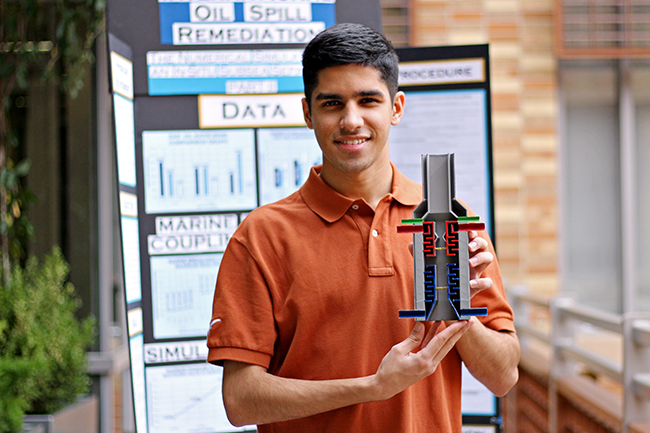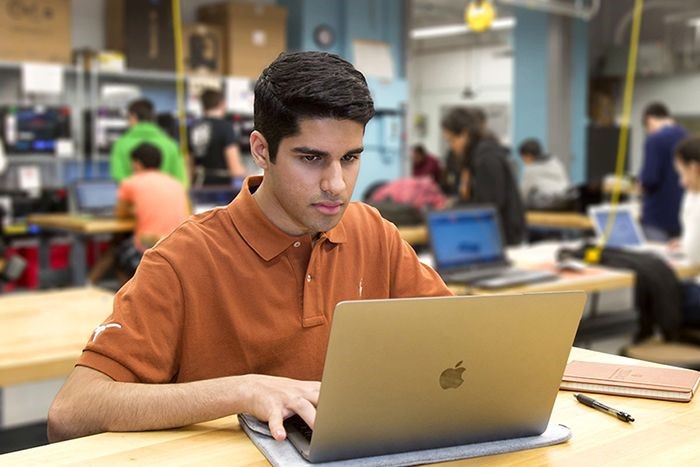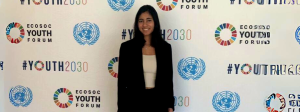(June 23, 2024) It was in the spring of 2010 that the world woke up on the morning of April 20 to an environmental disaster – the largest marine oil spill in history – the Deepwater Horizon oil spill off the coast of the United States in the Gulf of Mexico. Seeing the natural disaster happening in his own backyard, was a wake-up call for the Texas-resident Karan Jerath. “The fact that it happened in my backyard woke me up to the true nature of the environmental damage this was wreaking. I had to do something about it,” he said in an interview.

Karan Jerath
Still a teenager, he’d spend nine-ten hours daily researching and coming up with a device that could shut down undersea oil spills. After months of experimentation, he developed a groundbreaking device which won him $50,000 along with Intel’s Young Scientist Award. The feat also led him to feature in the Forbes 30 Under 30 Energy list for inventing a device that contains oil spills at the source.
A genius in the making
Born in Mumbai to an artist mother and a mechanical engineer father, Karan moved to Kuala Lumpur when he was one. “Living in Malaysia and attending the International School of Kuala Lumpur, I developed as a global citizen-one who recognises the necessity of harmonising opposing perspectives and becoming accustomed to a lifestyle of contrasting cultures,” he revealed. It was in 2008 that the family shifted to Friendswood in Texas, US where Karan’s scientific acumen started to take shape as he became involved with the school’s Science Fair program. “My engagement with this program is where I first developed an interest in engineering and sustainability issues,” the Global Indian wrote on his website.


Karan Jerath at a Science fair
Moving to the US was an intimidating experience for Karan as they didn’t know anybody in this new country. But slowly he started adjusting to the new culture and environment. But it was during his high school that he started getting interested in science and curious about new things. Science fairs turned out to be the perfect platform that allowed him to continue broadening his perspective and challenging him to solve problems with no definite solutions. They empowered Karan to both serve his local community and protect the environment on an international scale.
Finding a solution
It was in 2010 that the Deepwater Horizon oil spill happened that woke him up to the environmental crisis. “I wanted to think of a solution that addresses one of the biggest ongoing crises of the environment today, oil spills, that is systematically destroying our ocean environment. I started going to libraries and reading up on this, drawing different designs and coming up with blueprints,” added Karan, who later studied at the University of Texas.
With the help of his mentor, he engineered an innovative subsea wellhead containment device capable of capturing oil and gas escaping from a blowout well, separating the substances into liquids and gases, and storing them on a surface vessel. “The device is essentially a way to divert the spill from contaminating the ocean and keep it from devastating the marine life,” he added.
An advocate of STEM education, he has also participated in programs such as the HIVE Global Leaders Program at Harvard, and the MIT Global Entrepreneurship Bootcamp. “Both of these programs have allowed me to continuously diversify my experiences as a growing individual, a passionate researcher, and a contributor to society.”


Karan, who served as one of the United Nations Young Leaders for the Sustainable Development Goals (SDGs), has earned many accolades in his journey which are proof that nothing is impossible where there is determination, passion, and purpose. “Through my interest in science and engineering, I realized that if you want to help change the world, it doesn’t matter how old you are, where you’re from, or how much you know. It’s my goal to empower others to be interested in science and math, to want to make a difference by discovering new things, and most importantly, to give their time and talents to a cause they care deeply about.”
Karan Jerath’s innovation following the Deepwater Horizon oil spill exemplifies the transformative potential of visionary thinking in the face of environmental crises. By developing a groundbreaking device to contain oil spills at their source, Jerath not only addressed a critical challenge in oil spill management but also inspired a new generation of problem-solvers. His device, designed to capture and separate oil from the water directly at the point of leakage, represents a significant leap forward in mitigating the environmental damage caused by such disasters. His work underscores the impact that a single individual’s ingenuity can have on safeguarding our planet, reinforcing the critical role of technological advancement in environmental stewardship. His legacy is a powerful reminder that with determination and innovation, even the most daunting global challenges can be met with effective and practical solutions.




